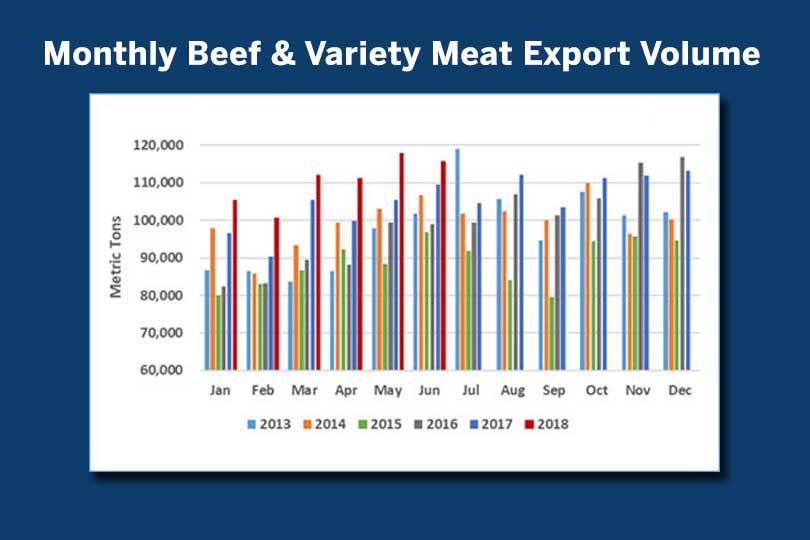By Jessica Domel
Multimedia Reporter
Despite recent trade uncertainty, global demand for U.S. beef continues to climb at a record pace.
In June, a record 90,745 metric tons of beef muscle cuts from the United States were exported to other countries. That’s up 15 percent from June 2017.
Total beef export volume in June was up six percent to 115,000 metric tons, valued at more than $718 million.
International customers are buying more U.S. beef and paying a premium for it, according to the U.S. Meat Export Federation (USMEF).
“It’s remarkable to think that as recently as 2010, beef exports for the entire year totaled $4 billion. Now that milestone has been reached in just six months,” Dan Halstrom, USMEF president and CEO, said. “This should be a source of great pride for the beef industry, which has remained committed to expanding exports even when facing numerous obstacles.”
Halstrom said with global demand hitting all cylinders, there’s plenty of room for future growth.
In June, more than 31,000 metric tons of U.S. beef, valued at $193.1 million, were sold to Japan.
Beef exports to South Korea were up 46 percent in June at 21,408 metric tons, valued at $154.8 million.
Exports to Mexico, Taiwan, Columbia, Ecuador and other markets also rose in June.
Sales of U.S. beef to China/Hong Kong were up 15 percent at 65,345 metric tons, valued at $510.8 million, in June.
In July, China increased the tariffs it weighs on U.S. beef products from 12 percent to 37 percent.
The impact those tariffs have on beef sales in China will likely not be seen until after Labor Day.
“Right now, we definitely can see some impact in the weekly sales data,” Joe Schuele, USMEF vice president of Communications, said in an interview with the Texas Farm Bureau (TFB) Radio Network. “It’s really hard to quantify it until you see actual tangible export data.”
Last year, the Chinese market reopened to U.S. beef, and about $31 million worth was exported to China during the second half of the year.
“We were on pace to exceed that this year, but it’s still a relatively small portion of our global beef exports,” Schuele said. “The real damage comes from the fact that it will slow the U.S. beef industry’s efforts to gain a foothold in China and have an impact on our future business.”
China is the fastest growing beef import market in the world, according to Schuele, and there’s a gap the U.S. beef industry is anxious to fill.
“We started to make some ground, make some progress in doing that, but a tripling of the tariff will definitely make that more difficult,” Schuele said.
U.S. trade officials continue to visit with foreign buyers to open and expand new markets for U.S. beef, but Schuele said it’s also important to maintain the market share that is already there.
“It’s not that we’re not exporting to other countries, but when you look at the volume of business that we do in—for example, Mexico and China—finding enough outlets to absorb that product is a very tall task,” Schuele said. “Other markets can certainly be the answer to some degree, but regaining full access, or what I would say is normal access, to China and Mexico needs to be a priority if the U.S. industry is going to be able to continue to support its current level of production.”
USMEF’s report on exports for June and the first half of the year is available here.

